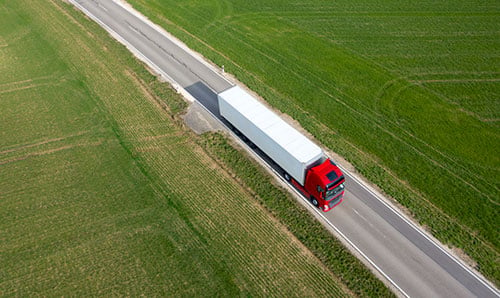CO2 emissions in Europe

CO2 tolls for trucks in EU member states
Following extensive discussions about new CO2 emissions-related tolls, they are now taking effect. Beginning 1 December 2023, commercial vehicles weighing over 7.5 tonnes have had to pay a CO2 emissions–related toll in Germany. The surcharge is €200 per tonne of CO2 and is based on new CO2 emissions classes. From 1 July 2024, the toll will be extended to vehicles weighing over 3.5 tonnes. In Austria, new partial toll rates took effect on 1 January 2024.
As your day-to-day mobility partner, UTA Edenred will help you to travel safely and efficiently throughout Europe. We’ll keep you updated on any steps you need to take to make the transition as easy as possible for you.

CO2 emissions-related toll in Germany effective 1 December 2023
A CO₂ toll for HGVs over 7.5 tonnes was introduced in Germany on 1 December 2023. Designed to promote the switch to low-emission, or better yet, zero-emission transportation, it represents an additional tariff.
The CO₂ surcharge is calculated based on the CO₂ emissions of a vehicle. Kilometres driven and an HGV’s CO₂ emissions are considered.
For the cost of traffic-related CO₂ emissions, a new rate component – the ‘proportional toll rate’ – has been introduced. It consists of a surcharge of €200 per tonne of CO₂.
Future toll rates will be comprised of four parameters:
Infrastructure costs
Air pollution
Noise pollution
CO₂ emissions
Toll fees are charged on trunk roads (e.g., main roads and motorways). Vehicles entering such a road, as well as connected fuel stations and
rest areas, are subject to tolls.
Please note: CO₂ tolls also apply to LNG vehicles.
CO2 emissions-related toll in Austria effective 1 January 2024
In Austria, the CO₂ toll applies to vehicles over 3.5 tonnes. Customers registered with the ASFINAG toll system in Austria must notify ASFINAG of their CO₂ emissions class and upload required documentation to the ASFINAG SelfCare Portal or submit via email (euroclass@asfinag.at) to ensure correct billing.
CO2 emissions-related toll in the Czech Republic effective 1 March 2024
CO₂ toll rates apply in the Czech Republic to vehicles over 3.5 tonnes. Information on registration and/or submission procedures can be found on the MYTO CZ website.
An overview of toll rates in the Czech Republic can be found here.
When do CO2 toll regulations come into force in EU member states?
Since 1 December 2023, commercial vehicles over 7.5 tonnes have paid a CO₂ emissions-related HGV toll in Germany. On 1 July 2024, the HGV toll will be extended to vehicles weighing over 3.5 tonnes.
The determination of vehicle groups is possible for vehicles weighing up to 5 tonnes. There is currently no determination method for CO₂ emissions available, so vehicles weighing between 3.5 and 5 tonnes can only receive a CO₂ emissions classification of 1 or 5.
An announcement will be made when the regulation comes into force in other EU member states.
We will keep you apprised of any developments on our website.
| Country | Implementation of toll rates according to CO₂ class |
|---|---|
| Germany | 01/12/2023 |
| Austria | 01/01/2024 |
| Czech Republic | 01/03/2024 |
| Denmark | 01/01/2025 |
| Eurovignette | planned: 25/03/2025 |
| Slovakia | planned: 07/2025 |
| Poland | planned: 2025 |
| Alsace | planned: 2026 |
There may be deviations from this depending on the transport policy decisions of the individual countries.
What is the CO₂ emissions class of my vehicle?
As your day-to-day mobility partner, UTA Edenred will help you register the CO2 emissions class of your vehicle. Classification in a lower CO2 emissions class enables you to save on toll costs!
Initially, your vehicle will be automatically classified in the highest (e.g., most expensive) CO2 emission class – class 1. We therefore suggest you check whether your vehicle falls into a better CO2 emissions class. You can use Toll Collect’s CO2 emissions class finder for this!
If your CO2 emissions class is better than 1, you can register your vehicle’s UTA One® next toll box in the UTA Service Center to obtain a better CO2 emissions class. We’d be happy to help. Get in touch!
Please note: If your vehicle is grouped into CO2 emissions class 1 today, this may change for a new vehicle. Every time you register, data will be requested.
Can I register my vehicle for a better CO₂ emissions class?
If a vehicle has a CO2 emissions class better than CO2 emissions class 1, it must be registered. The procedure depends on the on-board unit (OBU) used.
If you process tolls via the toll operator’s OBU, application/registration must be carried out with them. When using an EETS OBU such as UTA One®, UTA One® next or Telepass EU (AUT), details and verification documents must be uploaded to the UTA Service Center.
How do CO₂ emissions classes affect toll billing?
For future toll processing, you must specify the CO2 emissions class of your vehicle. Vehicles with low CO2 emissions benefit from lower toll fees while those with high CO2 emissions incur higher fees.
The following applies: The more environmentally friendly your vehicle is, the lower the toll rate will be.
What information is relevant for determining my vehicle’s CO₂ emissions class and where can I find it?
The required vehicle information can be found in your Certificate of Conformity (COC), Customer Information File (CIF) or vehicle registration. The details are:
- Technically permissible total weight when loaded (F.1) [kg]
- Specific CO2 emissions [gCO2/tkm]
- Date first registered
- Vehicle subgroup
- Wheel axle configuration
- Driver cabin with berth (sleeping cabin)
- Motor power rating [kW]
- Chassis configuration
To what vehicles do the CO₂ emissions classes apply?
Since 1 December 2023, five CO2 emissions classes apply to commercial vehicles in vehicle categories N2/N3 weighing over 7.5 tonnes. Vehicles are automatically classified in the highest, i.e., most costly, CO2 emissions class 1. Vehicles registered on or after 1 July 2019 can be registered for a better CO2 emissions class. Thusfar, the future reference values (PDF) for the CO2 emissions class determination have been defined for vehicle groups 4, 5, 9 and 10 with their subgroups.
There are currently no regulations or reference values for buses or vehicle subgroups of categories N2 and N3. Therefore, they are provisionally assigned to CO2 emissions class 1. Vehicles registered before July 2019 are automatically assigned to CO2 emissions class 1. Zero-emission vehicles registered before 1 July 2019 can be classified as CO2 emissions class 5 following submission of documentary proof.
Are there any exceptions or exemptions to the CO₂ emissions toll?
In Germany, zero-emission HGVs are exempt from the toll until 31/12/2025. From 1 January 2026, 25 percent of the standard toll rate will be collected to cover infrastructure costs. This corresponds to a toll reduction of 75 percent, plus charges for noise and air pollution.
Zero-emission electric and hydrogen vehicles as well as hydrogen fuel cell vehicles are exempt from tolls until the end of 2025 (for further information, see the Toll Collect article).
Zero-emission vehicles weighing up to 4.25 tonnes are permanently exempt from tolls. Benefits for light and heavy commercial vehicles with alternative, climate-friendly drives and associated alternative fuel and loading infrastructure have been extended until 2028.
Busses for passenger transport in Germany are exempt from tolls until further notice.

